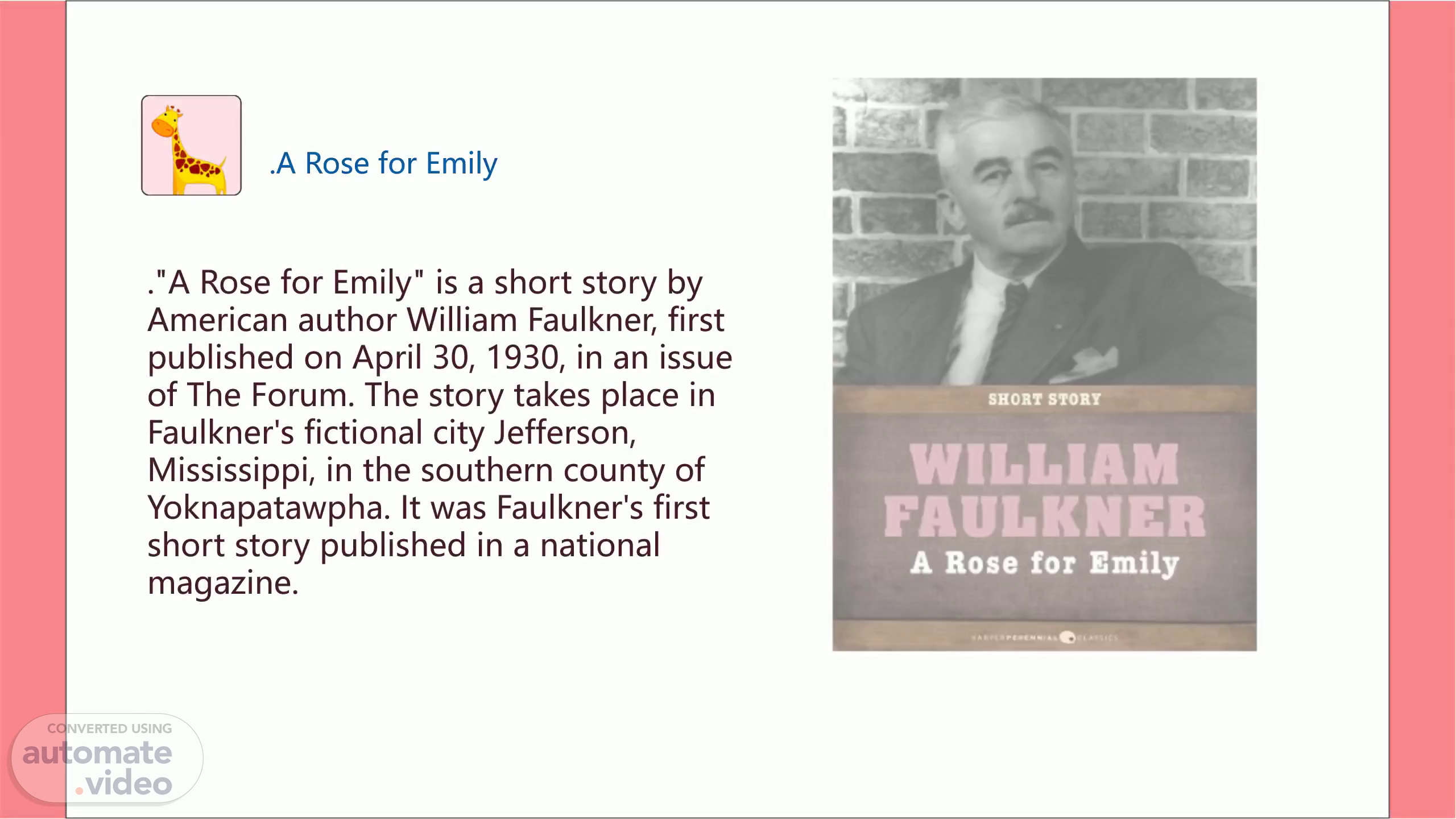Scene 1 (0s)
."A Rose for Emily" is a short story by American author William Faulkner, first published on April 30, 1930, in an issue of The Forum. The story takes place in Faulkner's fictional city Jefferson, Mississippi, in the southern county of Yoknapatawpha. It was Faulkner's first short story published in a national magazine..
Scene 2 (21s)
.Emily Grierson - The main character of the story. Emily's father kept her from seeing suitors and controlled her social life, keeping her in isolation until his death, when she is 30 years old..
Scene 3 (35s)
.Homer Barron - Emily's romantic interest. He is later found dead and decomposed in Emily's bedroom after her funeral..
Scene 4 (46s)
.Colonel Sartoris - The former mayor who remitted Emily's taxes. While he is in the story very little, his decision to remit Emily's taxes leads to her refusal to pay them ever again, contributing to her stubborn personality. The reason for Sartoris remitting her taxes is never given, only that he told Emily it was because her father loaned the money to the town..
Scene 5 (1m 6s)
.Mr. Grierson - Emily's father, the patriarchal head of the Grierson family. His control over Emily's personal life prohibited her from romantic involvement. The reason for his refusal to let Emily court men is not explained in the story..
Scene 6 (1m 21s)
.The cousins - Emily's extended relatives from Alabama. They come to town during Emily's courting of Homer Barron to check on Emily's well-being. They are thought of as even more uptight and stuffy than Emily by the townspeople.
Scene 7 (1m 37s)
.Tobe - Emily's cook/gardener, who also acts as her secret keeper. Tobe is a loyal individual to Emily. During the years of Emily's isolation, he provides no details of her life to the townspeople and promptly disappears directly following her death. He became old and stooped from all of his work while Emily grew large and immobile.
Scene 8 (1m 56s)
.Faulkner described the title "A Rose For Emily" as an allegorical title: this woman had undergone a great tragedy, and for this Faulkner pitied her. As a salute, he handed her a rose.
Scene 9 (2m 9s)
.The word "rose" in the title has multiple meanings to it. The rose may be seen as Homer when interpreting the rose as a dried rose. Homer's body could be the dried rose, such as one that is pressed between the pages of a book, kept in perfect condition as Emily did with Homer's body.
Scene 10 (2m 27s)
.The rose also represents secrecy. Roses have been portrayed in Greek legends as a gift of secrecy and of confidentiality, known as sub rosa, implying that the rose is a symbol of silence between the narrator and Miss Emily, whose secrets the narrator keeps until her death.
Scene 11 (2m 44s)
. People should let go of the past, moving on with the present so that they can prepare to welcome their future. Emily was the proof of a person who always lived on the shadow of the past; she clung into it and was afraid of changing..
Scene 12 (3m 0s)
.“At last they could pity Miss Emily. Being left alone, and a pauper, she had become humanized. ”.
